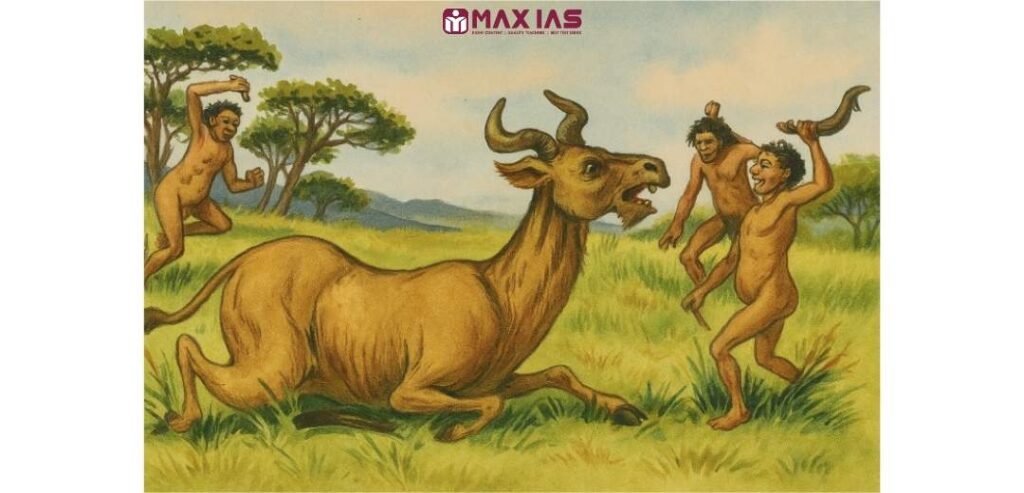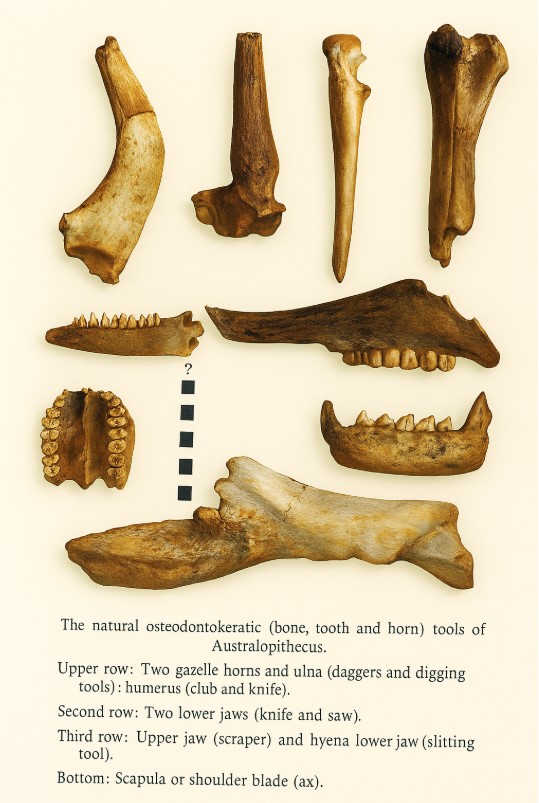The term “osteodontokeratic” combined the Greek roots for bone (“osteo”), teeth (“odonto”), and horn (“cerat”), which gives the “bone-tooth-horn” culture. Raymond Dart named the tool technology the osteodontokeratic
In the 1960s, a concept emerged suggesting that Australopithecus functioned as a “killer ape,” engaging not only in the hunting of other animals but also in the violent behaviour of killing one another. The foundation of the killer ape theory can largely be traced back to the discoveries made by Raymond Dart, who is credited with identifying Australopithecus africanus.

Australopithicines clubbing Griquatherium
Raymond Dart made a painstaking analysis of several thousand bone fragments from Makapansgat, South Africa, and concluded they were used and left in the cave by Australopithecus. Certain animal bones predominated in the deposits, whereas other body parts were not represented at all, suggesting to Dart that particular animal bones were intentionally brought into the cave for specific purposes.
For example, mandibles were most common, leading Dart to suggest that the teeth were utilised as scrapers, saws, or “slashing” tools. Broken bones, many with jagged edges and sharp points, could have been daggers or knives. The bone cores of bovid horns were also commonly preserved— the horns were seen by Dart as pounding, digging, or jabbing tools, or even weapons wielded in the hands of Australopithecus. Virtually every bone in the
Makapansgat deposit was postulated to have had a function, from scapular blades to cranial bowls. Dart thus envisioned Australopithecus as a successful hunter, making tools from the remains of its prey.
Even some of the Australopithecus bones, particularly a broken juvenile mandible, were seen to be the product of a “killer ape” that sometimes turned its predatory habits on its own kind.

Dismissal of osteodontokeratic culture
Dart’s hypothesis did not receive widespread acceptance among contemporaneous scientists, including Kenneth Oakley, Sherburn Washburn, John Robinson, and C. K. “Bob” Brain. This lack of consensus prompted Brain to undertake independent field research focused on the agents responsible for fossil accumulation and the processes involved in site formation in South Africa.
Brain presented an alternative interpretation grounded in taphonomic observations of carnivore behavior. He raised significant concerns regarding Dart’s osteodontokeratic culture,. Brain contended that the South African cave sites do not represent actual human habitation; rather, the bone accumulations reflect passive collections by natural agents. It has been suggested that hyenas and porcupines could have been responsible for these bone accumulations in the caves, as continues to be observed today.
In his studies from 1968 and 1970, Brain examined hyena scavenging behavior on carnivore carcasses, noting that only minor portions of bone typically remained following extensive scavenging activities. The remains observed are consistent with those found in the Makapansgat cave deposits. Additionally, leopards appear to have contributed to the formation of South African bone accumulations. These felines exhibit a behavior of transporting their prey into tree branches to avoid scavengers and to consume their meals at leisure. Trees are frequently located near cave openings in the high veld of South Africa, suggesting that some remains from leopards may have inadvertently fallen into these cave sites. Furthermore, leopards occasionally utilize the caves themselves for the storage of prey. Brain’s research from 1974 has demonstrated that two puncture marks on the occipital bone of a partial Australopithecus robustus skull at Swartkrans correspond to the lower canines of a fossilized leopard. Consequently, Brain concluded in 1981 that australopithecines were not the hunters but rather the hunted.
As a result, the osteodontokeratic culture has been largely dismissed. Nonetheless, this assertion does not preclude the possibility that Australopithecus utilized bone tools; indeed, there remain unexplained artifacts at Makapansgat, such as small bones inserted into larger bones, which may have functioned as reamers for marrow extraction. However, there exists insufficient evidence to support the notion that early hominids were regular toolmakers or proficient predators.


